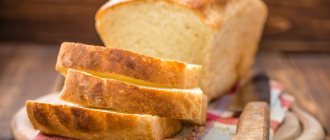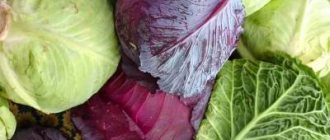If stored improperly, baked goods spoil very quickly. To avoid rapid spoilage of bread, so that it stays fresh longer and does not become moldy, you need to know and understand how to properly store baked goods and how to care for the storage area.
IMPORTANT. In stores, canteens, and factories, established standards are used for the care of racks and shelves on which baked goods are stored. This eliminates the possibility of fungal development. By regularly treating it with a specially prepared vinegar solution, you can maintain cleanliness in the bread bin at home, which is very important.
Storing bread bread diseases
The main causes of bread diseases include the use of low-quality flour, violation of production technology and non-compliance with bread storage conditions.
In most cases, bread is affected by mold fungi. They leave characteristic spots of gray, yellow, green on the crumb. The main pathogens of mold on bread are two types of fungi:
It is noteworthy that the reason for the activation of fungi is not only a violation of the shelf life, but also the use of low-quality flour with microbiological indicators that do not comply with GOST. In raw materials infected with spores of moldy fungi, mycotoxins accumulate, which penetrate into the finished bread during the production process. Then, the finished loaves of bread become covered with spots of mold as soon as they are exposed to suitable conditions with high humidity and stagnant air.
It is important to note that bread with traces of mold is not recommended for consumption. Even cutting off the affected areas and burning the loaf with fire does not completely remove the fungal mycelium threads, which quickly spread throughout the crumb. Regular consumption of moldy bread can cause various diseases in humans:
During storage, bread can be affected not only by fungi, but also by yeast, potato bacillus and other microorganisms.
Common bread diseases:
Why does bread spoil quickly?
Any flour products deteriorate in 2 ways: they become stale or become moldy. Stale bread becomes tasteless, and moldy bread becomes dangerous to human health. During baking, the starch contained in the flour absorbs liquid and turns into a paste. Over time, the paste releases moisture, it evaporates and the baked goods become stale. Stale crumb absorbs gastric juice more slowly, which means it is poorly digested and absorbed.
Mold and other harmful organisms that can cause spoilage of buns always live on the shell of the grain. When grinding, they fall into flour, and then into the product. If it is not baked well, fungal spores will germinate and multiply. The golden crust is disinfected under the influence of high temperature during the baking process, and it takes more time to completely cook the crumb in the middle of the bun.
Shelf life of bread
The time frame established for preserving the freshness of bread by GOST is determined by such indicators as the type of bread and the environmental conditions in which it is stored.
The shelf life of bread is short. The countdown begins immediately after production. Within 6-24 hours (each type of bread has its own aging period at the bakery), freshly baked bread must be delivered to the store. A maximum of 36 hours is allotted for implementation. As a result, the buyer has 1-2 days left to eat the purchased bread.
The shelf life of each type of bread is different and is shown in the table below.
Is it possible to eat expired product?
Expired bread can be of two types:
- Moldy ones go only for disposal. Mold spores are not killed by heat, drying, or frost. Maturing mold produces substances that are toxic to humans. In addition, additives in the form of preservatives and flavorings are also harmful, and if expired, they are doubly dangerous.
- Dried can be partially restored and consumed within a short time.
You should not stock up on bread if there is no feast coming up. This is not a scarce product, and fresh is much tastier than stale, even for a day. However, you can extend the shelf life with the right approach.
Storage conditions for bread and bakery products
The activity of bread staling is determined by such indicators as air temperature and humidity, type of product, as well as the presence of packaging and its quality. Therefore, it is necessary to store bakery products under the following conditions with mandatory adherence to the established deadlines:
The maximum intensity of staling is observed at a temperature of -2-+20°C. The staling process stops completely at temperatures below -10°C. Therefore, freezing as a storage method is very effective, but expensive. It is much more profitable to sell bakery products in packaging that extends their shelf life.
Thus, it is recommended to pack bread in plastic film or special paper. Its use allows you to extend the shelf life of bread up to 72 hours (according to GOST).
General sanitary requirements
The premises selected for storing bread must meet certain criteria. The main ones are:
- maximum dryness;
- availability of high-quality ventilation.
The requirements for storage, trade and transportation of the product in question contain the relevant Rules, put into effect in 1983 by Order 228 of the USSR Ministry of Trade.
An important point is that as soon as products are removed, it is necessary to thoroughly clean racks, shelves, containers and boxes from:
- crumbs;
- flour powder;
- other product remnants.
They must also be wiped dry.
In situations where even subtle signs of damage to baked goods by potato sticks or other microflora are detected, the local unit of the State Sanitary and Epidemiological Supervision should be immediately notified. In this case, the entire delivered batch is withdrawn both from the warehouse and directly from the sales floor. How to use it in the future is decided by specialists after conducting the necessary tests.
Workers responsible for the sanitary condition of the premises are required to thoroughly wash with disinfectants all shelves, cabinets, and racks where contaminated products were previously stored. Current regulations require that in this case, disinfection be carried out with a solution of acetic acid with a strength of at least 3 percent.
What solution is used to wipe bread storage shelves?
The place where bread is stored must be regularly cleaned and ventilated. The shelves on which bread is stored must be treated with a special solution. This helps prevent mold growth and unpleasant odors.
To begin with, the shelves are wiped with soapy water, then treated with a 1% vinegar solution. Then the surface is wiped dry and allowed to dry completely. This procedure is regulated by SanPiN and is mandatory in production.
It is not advisable to wipe shelves with undiluted acetic acid. This can affect the taste of the bread and cause an unpleasant odor.
Seven principles of HACCP
Essentially, HACCP is a system for identifying, assessing and managing hazards that affect food products. It also involves the development of special documentation for these purposes. The purpose of HACCP is to prevent risks before they actually appear.
There are seven principles on which the HACCP system is based:
1. Risk analysis through assessing the significance of hazardous factors at all stages of working with products.
Why it is necessary: when risks are identified, measures can be formulated to prevent them.
2. Determination of critical control points.
Why you need it: helps prevent potential danger.
3. Determination of critical limits for control points.
Why you need it: by understanding the limits, you can act so that at critical points the situation does not get out of control.
4. Implementation of monitoring procedures for all critical control points.
Why you need it: allows you to install a surveillance system and supervision at critical points.
5. Formulation of corrective actions.
What is it for: helps in situations where observations signal a possible situation getting out of control.
6. Maintaining and recording documentation.
Why you need it: a document management system allows you to mark important data.
7. Implementation of document verification procedures.
Why you need it: allows you to monitor the relevance of information and the implementation of all necessary actions.
How to store bread in the kitchen
You need to store bread at home correctly:
- After purchasing, it is better to remove the bread from the plastic packaging. If the packaging is paper, you can simply open it slightly. It is best to wrap the bread in a cotton or linen cloth. This will allow the bread to breathe and not go stale prematurely.
- Bread bins manufactured in accordance with GOST ensure the freshness of bread for 60 hours. If different types of bread are stored in a bread bin at the same time, it is advisable to wrap each loaf in a separate paper bag or fabric bag.
- You can store bread in the refrigerator for up to 7 days. The product can be kept in a bag with holes to prevent condensation. A suitable place is the bottom shelf. Wheat bread retains its freshness well in the refrigerator, but black and Borodino bread does not store well in conditions of low air temperature.
Useful tips
To prevent the bread from going stale longer, cut pieces not from the edge, but from the middle: divide the loaf in half, cut the required amount from the middle. Connect the remaining halves with slices, pressing them tightly against each other.
If the bread is slightly stale, you can refresh it. Spray the product with water or wrap it briefly in a damp towel. Then place in an oven preheated to +120 ℃ for 10-15 minutes. The bread will restore freshness and softness for several hours (wheat up to 5 hours, rye up to 9 hours).
To prevent mold, place a handful of salt or an apple slice in the bread bin (they need to be changed periodically). Charcoal wrapped in gauze will get rid of excess moisture and unpleasant odors.
To prevent the bread from getting stale during the festive feast, serve it to the table in a wicker basket, wrapped in a linen towel.
Remember that bread made with yeast-free sourdough is stored better than bread made with yeast dough, as it is less susceptible to the development of fungus. The product will remain fresh longer (7-8 days) if you use vegetable rather than animal fats for cooking.
Bread bin for storing bread, which one is better?
The choice of home bread bin depends solely on personal preferences and ease of use:
- A wooden bread box is the most environmentally friendly in terms of material used. In addition, the wooden product has a beautiful design and convenience. But, a wooden bread box quickly absorbs foreign odors, which are transferred to baked goods during operation. Due to temperature changes and sudden changes in humidity, wood easily swells and then cracks. Another significant drawback is the inability to fully wash the product.
- The plastic bread box is easy to clean and durable. Plastic is easy to care for, which allows you to get rid of odors, mold, and crumbs in a timely manner. The disadvantage is that it is not always possible to be sure of the quality of the plastic and the absence of toxic compounds in it.
- A stainless steel metal bread box is an ideal option. This metal is not afraid of moisture, cleaning agents and odors. This bread box is durable and is not afraid of impacts or corrosion.
- Bread bins made of glass and ceramics fit well into any interior, while perfectly preserving the freshness of bread. Disadvantage: increased fragility.
How to store bread in the refrigerator
At low temperatures, the process of bread staling slows down significantly. Therefore, bread can be stored in it for up to 7 days. But, the refrigerator is not the most suitable place for storage.
- Firstly, the refrigerator is filled with different aromas of dishes and products. In any case, they will penetrate the bread and even a plastic bag will not become an obstacle to this.
- Secondly, there is high humidity in the refrigerator compartment. This is what will cause the bread to become moldy.
- Thirdly, if the bread you put in the refrigerator is already contaminated with fungal spores, the entire refrigerator compartment will be contaminated.
Second life of a loaf
What to do if the bread still goes stale:
- You can breathe “second life” into it by lightly moistening it with water and holding it in the oven for 1-2 minutes at a temperature of 40-50 °C.
- You can moisten a stale loaf with sweetened water and vanilla, and after the microwave you will eat a nice, fresh baked good.
- You can also use a "water bath". Pour some water into a large saucepan and place on the fire. Place the bread in a colander so that it is surrounded by moist steam, cover with a lid. After a few minutes the loaf will become soft. The taste of fresh baked goods will not return, but it will turn out quite edible.
Dried bread is preferable to fresh bread for a number of gastrointestinal diseases. It is also useful for those who are on a diet
If the bread has completely become stale, and you are not going to “reanimate” it, there are many options for using it in this form:
- White crumb soaked in milk, if added to minced meat, will make the cutlets fluffy and tender.
- You can dry the leftovers and grind them to make breadcrumbs.
- Cut the stale pieces into small pieces and make croutons. Black ones can be sprinkled with salt - why not a snack to go with beer?
- Store the crackers in a cotton bag. This will be your emergency reserve. Sooner or later it will happen that you will forget to buy bread for lunch. Throw a handful of croutons into a plate of broth and you have croutons. These croutons can also be thrown into a frying pan with scrambled eggs.
In the culinary literature you will find many descriptions of dishes using stale bread - from casseroles to desserts. There are also videos dedicated to this topic:
Now you know the secrets of saving bread and baked goods, how to store them in the refrigerator, and that bread can be frozen. However, this product is intended for quick consumption. Therefore, try to buy bread in moderation.
Store correctly and be healthy!
Bread in the freezer, how to defrost it afterwards
Storing bread in the freezer ensures long-term preservation of its freshness and vitamin and mineral composition. True, only fresh or, at least, yesterday’s bread is suitable for freezing.
The optimal way to freeze bread is to first cut the loaf into pieces, then place them in a freezer bag or foil. This makes it much easier to defrost bread. Defrosting is carried out at room temperature for 3-4 hours.
Effective operation time depending on category
The period of effective operation of PPR pipes is influenced by 3 indicators:
- working temperature;
- Nominal pressure category (PN);
- maximum permissible pressure (P).
Comparison table showing actual service life in relation to pressure and temperature:
| Service life, years | Temperature, degrees | P for PN10, MPa | P for PN16, MPa | P for PN20, MPa | P for PN25, MPa |
| 10 | 20 | 1,32 | 2,13 | 2,13 | 3,31 |
| 25 | 20 | 1,29 | 2,05 | 2,59 | 3,23 |
| 50 | 20 | 1,25 | 2,03 | 2,53 | 3,17 |
| 10 | 50 | 1,37 | 1,7 | 2,3 | 2,13 |
| 25 | 50 | 0,79 | 1,25 | 1,58 | 1,96 |
| 50 | 50 | 0,71 | 1,15 | 1,44 | 1,8 |
| 10 | 70 | 0,52 | 0,83 | 1,05 | 1,3 |
| 25 | 70 | 0,44 | 0,71 | 0,89 | 1,16 |
| 30 | 70 | 0,43 | 0,68 | 0,86 | 1,08 |
| 50 | 70 | 0,42 | 0,66 | 0,83 | 1,06 |
| 5 | 80 | 0,42 | 0,68 | 0,85 | 1,06 |
| 10 | 80 | 0,38 | 0,62 | 0,77 | 0,96 |
| 25 | 80 | 0,36 | 0,57 | 0,72 | 0,9 |
The period of effective use is also affected by the quality of installation and raw materials used for manufacturing.
This must be taken into account when paying attention to the labeling











